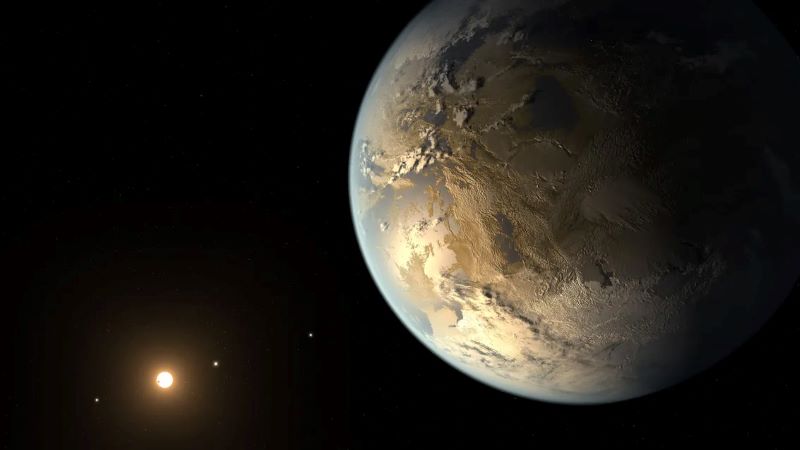On June 4, 2025, a NASA astronomical team officially confirmed the discovery of Kepler-725c, an exoplanet with “super-Earth” characteristics, about 1,400 light-years away from Earth in the constellation Cygnus. The discovery, which resulted from a reanalysis of data collected by the Kepler Space Telescope, not only refreshes humanity’s knowledge of Earth-like planets but also reinvigorates the “Search for a Second Earth” exploration program.
According to NASA Goddard Space Flight Center researchers, Kepler-725c is a rocky planet orbiting a sun-like star, with a diameter of about 1.5 times that of the Earth, and belongs to the “super-Earth” category. What’s more, the planet is in the “habitable zone” of its parent star – a region where liquid water may exist on the surface, meaning it has some potential for habitation.
Data reconstruction reveals the missing planet
Kepler-725c was not identified at the beginning of the Kepler mission. The mission’s raw data had failed to detect its presence due to a weak signal. With advances in artificial intelligence algorithms and highly sensitive observational tools, NASA and multiple research institutions conducted a new round of analysis of the old data, eventually confirming Kepler-725c’s periodic transiting signal in early 2025. “The planet had previously been misidentified as background noise in the data,” noted NASA exoplanet scientist Carolyn Matthews in a press release, ‘and it took the use of an enhanced light-change curve analysis system for us to finally get it out of the ’background of the universe’ ‘ to identify it.” According to observations, Kepler-725c orbits its parent star with a period of 34 Earth days. Its parent star is slightly less luminous than the Sun, so even with its relatively close orbit, it still lies within the theoretical habitable zone.
The scientific community is still in dispute
Although the physical conditions of Kepler-725c seem “ideal”, scientists are still cautious about its suitability for life. According to preliminary modeling data released by NASA, the planet may have a thick atmosphere, which could produce a strong greenhouse effect. If so, its surface temperature may exceed the upper limit of what life can tolerate. “From Earth, it does look a lot like ‘Earth enlarged’, but we can’t say it’s ‘habitable’ yet.” Lisa Holdeman, an astrophysicist at the University of California, Santa Cruz, said, “We don’t yet have definitive information about the composition of its atmosphere, and whether it contains oxygen, water vapor, or carbon dioxide is unknown.” In the future, scientists will attempt to spectroscopically analyze Kepler-725c’s atmosphere using the James Webb Space Telescope (JWST) to determine whether an Earth-like life-supporting environment exists.
What does “super-earth” mean?
A “super-Earth” is an Earth-like planet that is larger than Earth but smaller than ice giants such as Uranus and Neptune. There are far more of these planets in the Milky Way than science once predicted, and Kepler-725c is one of the most recently confirmed members. According to NASA, more than 1,600 “super-Earths” have been recognized since 2009. Most of them are located in the habitable zones of other galaxies, but few of them can be truly defined as “habitable” or “Earth-like” planets. pathways and possible life evolution pathways. “This is a small but significant step closer to understanding the diversity of life in the universe.” Dr. Daniel Kraus, Planetary Mission Advisor at the European Space Agency (ESA), said, “Kepler-725c provides concrete directions for future deeper exploration missions.”

Insights for future missions and technology development
The confirmation of Kepler-725c also has implications for future exoplanet exploration strategies, as NASA’s Habitat space telescope, which is already scheduled to launch in 2026, will prioritize targeting “candidate habitable planets” including Kepler-725c. Habitat will be equipped with a high-resolution spectrometer that will analyze trace components of these planets’ atmospheres to determine their habitability. In addition, the ground-based Extremely Large Telescope (ELT) array and the Vela Telescope (VLT) in Chile will also be involved in long-term follow-up observations of the planetary system in the coming years. It is worth noting that Kepler-725c has a short rotation period and will enter its “optimal observing window” several times in the coming years. This will provide astronomers with more opportunities to continuously acquire spectral data at different wavelengths and with different accuracies to further characterize its geology and climate.
Conclusion
The discovery of Kepler-725c is not only a demonstration of NASA’s deep space exploration capabilities, but also opens a new window for mankind to search for a second Earth. Although its habitability is still inconclusive, the discovery has inspired the global astronomical science community to continue to dig deeper into the exoplanet database and to promote the continuous progress of technology and methodology. On the road to exploring the universe, the confirmation of each “super-Earth” is a step towards the interstellar civilization of mankind. Kepler-725c may one day become a model or a target for human planetary migration, writing a new space chapter for future generations.













Leave a comment